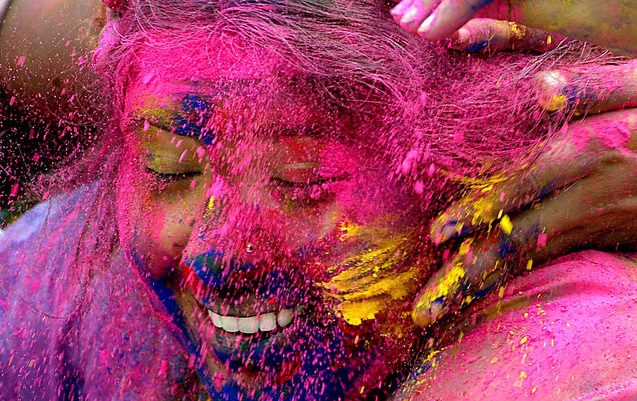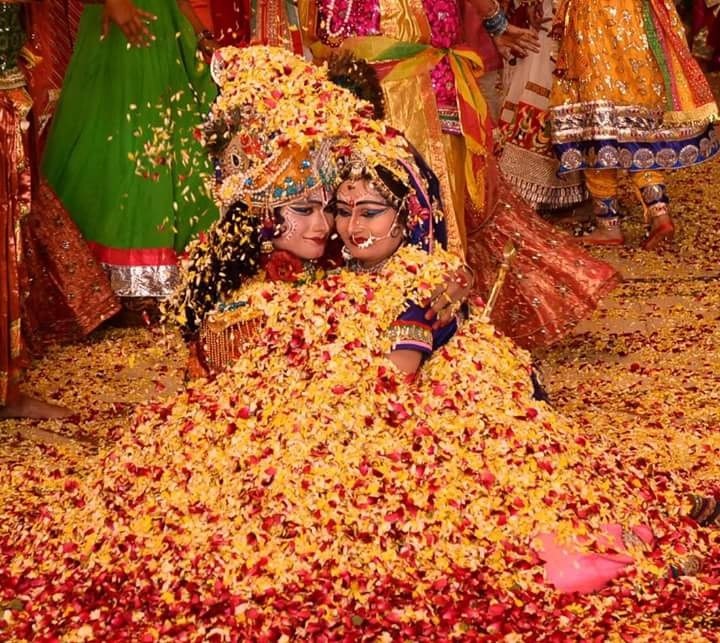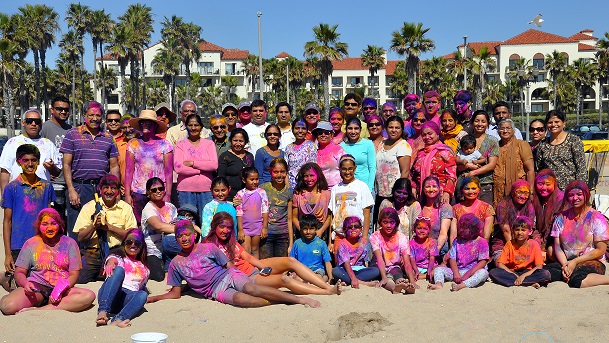Holi – The Festival Of Colors

Holi – the festival of colors – is undoubtedly the most fun-filled and boisterous Hindu festival. It is called Dol Purnima or Dola Jatra in Bengal and Odisha, dedicated to Lord Krishna, or Basanto Utsav in West Bengal and Assam. The customs and celebrations vary between regions of India. But It’s an occasion that brings in unadulterated joy and mirth, fun and play, music and dance, and of course lots of bright colors!
Holika Dahan is on 24th March 2024 (Sunday) and Holi and Dhulandi are on 25th March 2024 (Monday). What is Holika Dahan
Happy Days Are Here Again!
With winter neatly tucked up in the attic, it’s time to come out of our cocoons and enjoy this spring festival. Every year it is celebrated on the day after the full moon in early March and glorifies the good harvest and fertility of the land. It is also time for spring harvest. The new crop refills the stores in every household and perhaps such abundance accounts for the riotous merriment during Holi. This also explains the other names of this celebration – ‘Vasant Mahotsava‘ and ‘Kama Mahotsava‘.
“Don’t Mind, It’s Holi!”
During Holi, practices, which at other times could be offensive, are allowed. Squirting colored water on passers-by, dunking friends in mud pool amidst teasing and laughter, getting intoxicated on bhaang, and reveling with companions is perfectly acceptable. In fact, on the days of Holi, you can get away with almost anything by saying, “Don’t mind, it’s Holi!” (Hindi = Bura na mano, Holi hai.)
The Festive License!

Women, especially, enjoy the freedom of relaxed rules and sometimes join in the merriment rather aggressively. There is also much vulgar behavior connected with phallic themes. It is a time when pollution is not important, a time for license and obscenity in place of the usual societal and caste restrictions. In a way, Holi is a means for people to ventilate their ‘latent heat’ and experience strange physical relaxations.
Legends & Myths
Like all Indian and Hindu festivals, Holi is inextricably linked to mythical tales. There are at least three legends that are directly associated with the festival of colors: the Holika-Hiranyakashipu-Prahlad episode, Lord Shiva’s killing of Kamadeva, and the story of the ogress Dhundhi.
The Holika-Prahlad Episode
The evolution of the term Holi makes an interesting study in itself. Legend has it that it derives its name from Holika, the sister of the mythical megalomaniac king Hiranyakashipu who commanded everyone to worship him. But his little son Prahlad refused to do so. Instead, he became a devotee of Vishnu, the Hindu God.
Hiranyakashipu ordered his sister Holika to kill Prahlad and her, possessing the power to walk through fire unharmed, picked up the child and walked into a fire with him. Prahlad, however, chanted the names of God and was saved from the fire. Holika perished because she did not know that her powers were only effective if she entered the fire alone.
This myth has a strong association with the festival of Holi, and even today there is a practice of hurling cow dung into the fire and shouting obscenities
at it, as if at Holika.
The Story of Dhundhi
It was also on this day that an ogress called Dhundhi, who was troubling the children in the kingdom of Prthu was chased away by the shouts and pranks of village youngsters. Although this female monster had secured several boons that made her almost invincible, shouts, abuses, and pranks of boys were a chink in the armor for Dhundi, owing to a curse from Lord Shiva.
The Kamadeva Myth
It is often believed that it was on this day that Lord Shiva opened his third eye and incinerated Kamadeva, the god of love, to death. So, many people worship Kamadeva on Holi-day, with the simple offering of a mixture of mango blossoms and sandalwood paste.
Radha-Krishna Legend

Holi is also celebrated in memory of the immortal love of Lord Krishna and Radha. The young Krishna would complain to his mother Yashoda about why Radha was so fair and he so dark. Yashoda advised him to apply color on Radha’s face and see how her complexion would change. In the legends of Krishna as a youth, he is depicted playing all sorts of pranks with the gopis or cowgirls. One prank was to throw colored powder all over them. So at Holi, images of Krishna and his consort Radha are often carried through the streets. Holi is celebrated with eclat in the villages around Mathura, the birthplace of Krishna.
History
Holi is a festival that seems to have started several centuries before Christ as can be inferred from its mentions in the religious works of Jaimini’s Purvamimamsa-Sutras and Kathaka-Grhya-Sutra.
Holi in Temple Sculptures
Holi is one of the oldest among Hindu festivals, there is no doubt. Various references are found in the sculptures on walls of old temples. A 16th-century panel sculpted in a temple at Hampi, capital of Vijayanagar, shows a joyous scene depicting Holi where a prince and his princess are standing amidst maids waiting with syringes to drench the royal couple in the colored water.
Holi in Medieval Paintings
A 16th century Ahmednagar painting is on the theme of Vasanta Ragini – spring song or music. It shows a royal couple sitting on a grand swing, while maidens are playing music and spraying colors with pichkaris (hand-pumps). A Mewar painting (circa 1755) shows the Maharana with his courtiers. While the ruler is bestowing gifts on some people, a merry dance is on, and in the center is a tank filled with colored water. A Bundi miniature shows a king seated on a tusker, and from a balcony above some damsels are showering gulal (colored powders) on him.
Birthday of Shri Chaitanya Mahaprabhu
Holi Purnima is also celebrated as the birthday of Shri Chaitanya Mahaprabhu (A.D. 1486-1533), mostly in Bengal, and also in the coastal city of Puri, Orissa, and the holy cities of Mathura and Vrindavan, in the state of Uttar Pradesh.
Making the Colors of Holi
The colors of Holi, called ‘gulal’, in medieval times were made at home, from the flowers of the ‘tesu’ or ‘palash’ tree, also called ‘the flame of the forest’. These flowers, bright red or deep orange in color, were collected from the forest and spread out on mats, to dry in the sun, and then ground to fine dust. The powder, when mixed with water, made a beautiful saffron-red dye. This pigment and also ‘aabir’, made from natural colored talc, which was extensively used as Holi colors, are good for the skin, unlike the chemical colors of our days.

Read: Best Places To Celebrate Holi in India
How to Celebrate
Colorful days, solemn rituals, joyous celebrations – Holi is a boisterous occasion! Draped in white, people throng the streets in large numbers and smear each other with bright-hued powders and squirt colored water on one another through pichkaris (big syringe-like hand-pumps), irrespective of caste, color, race, sex, or social status; all these petty differences are temporarily relegated to the background and people give into an unalloyed colorful rebellion. There is an exchange of greetings, the elders distribute sweets and money, and all join in the frenzied dance to the rhythm of the drums. But if you wanna know how to celebrate the festival of colors to the fullest through the whole length of three days, here’s a primer.
Holi-Day 1
The day of the full moon (Holi Purnima) is the first day of Holi. A platter (‘thali’) is arranged with colored powders, and colored water is placed in a small brass pot (‘lota’). The eldest male member of the family begins the festivities by sprinkling colors on each member of the family, and the youngsters follow.
Holi-Day 2
On the second day of the festival called ‘Puno’, images of Holika are burnt in keeping with the legend of Prahlad and his devotion to Lord Vishnu. In rural India, the evening is celebrated by lighting huge bonfires as part of the community celebration when people gather near the fire to fill the air with folk songs and dances. Mothers often carry their babies five times in a clockwise direction around the fire, so that their children are blessed by Agni, the god of fire.
Holi-Day 3
The most boisterous and the final day of the festival is called ‘Parva’, when children, youth, men, and women visit each other’s homes and colored powders called ‘aabir’ and ‘gulal’ are thrown into the air and smeared on each other’s faces and bodies. ‘Pichkaris’ and water balloons are filled with colors and spurted onto people – while young people pay their respects to elders by sprinkling some colors on their feet, some powder is also smeared on the faces of the deities, especially Krishna and Radha.
Holi 2024 – Holi Messages, Wishes, Sms, Images and Facebook Greetings







